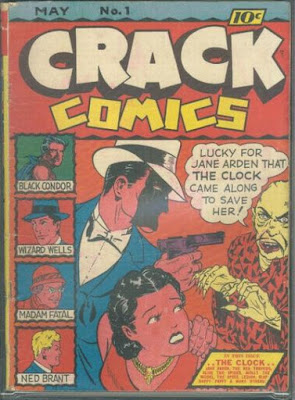Cover possibly by Ed Cronin
'The Clock Strikes' (by George Brenner): The Clock has made the jump over from Feature Comics to become this comic's headliner. This is one of his stronger outings, as he helps a guy named Pug who can no longer find work due to a murder that he committed in self defense. Together they smash a crime racket that goes all the way to the mayor (who is wearing an awesome Cobra Commander suit). Pug becomes the Clock's new sidekick, though I'm not entirely sure what he's going to bring to the strip. His redemption story works well here, but he doesn't seem interesting or different enough from the Clock to justify becoming a regular.
'Jane Arden' (by Monte Barrett and Russell E. Ross): Jane Arden has also made the switch, not been cancelled as I had previously thought. She's still in the middle of a storyline, which doesn't seem all that wise in a first issue, but at least it gets wrapped up quickly when the criminal Jim Southern is caught and arrested. A new story begins, with a murder mystery on a train. It's all very competently done without ever being exciting.
'The Space Legion' (by Vernon Henkel): Introducing Rock Braddon! The Space Legion are sort of like galactic police. In this story, Braddon takes on a gang of pirates that have stolen a shipment of radium. It's pretty much the sort of "space ships and ray guns" story you would expect, and does a good enough job of it. I'm still puzzled as to how Braddon survives an atomic bomb blast, though; it goes off right next to him!
'Alias the Spider' (by Paul Gustavson): The Spider is a crime-fighter who specialises in archery. That's about all we learn about him in this story, in which he tracks down and kills a criminal mastermind known as the Cricket. It's not bad, and the art has some creepy atmosphere in places, but the best thing about it is the title. 'Alias the Spider' just sounds rad.
'Wizard Wells, Miracle Man' (by Harry Francis Campbell): Wizard Wells is a scientist, and his assistant Tug is a punch-drunk ex-fighter. They don't seem to be professional crime-fighters, but in this story they help a girl against crooks that are trying to get her to pay protection money. The gimmick here is that Wells uses science to defeat his enemies, complete with explanations for the kids.
'Molly the Model' (by Joe Devlin): This is a series of one-page gag strips about a model and her prize fighter boyfriend. Amusing enough, and the cheesecake factor is the highest I've seen so far in this blog.
'Ned Brant' (by Bob Zuppke and E.W. Depew): Oh no, not Ned Brant as well! In this story Ned's basketball team beats the national champions. The plot works well enough, but the actual game is incomprehensibly written.
'Lee Preston of the Red Cross' (by Bob Powell): Lee Preston becomes enamoured with the idea of flying, and after months of training she becomes a Red Cross pilot. In this story she helps save some hillbillies from a flood. It's nice to see a new genre being tried out, but I've got a feeling that this is going to get formulaic very quickly.
'The Red Torpedo' (by Henry Kiefer): The Red Torpedo is Jim Lockhart, who invents a torpedo-like craft that he pilots himself. In this story he saves a refugee ship from enemy submarines. For a hero whose only gimmick is his vehicle to work, the vehicle has to be really cool. The torpedo has a couple of basic tricks, but it's just not rad enough.
'Corning's Mistake' (by Larry Spain): In this prose story, a builder makes his building too large, and is forced by his competitor to shave six inches from one side. Instead he shaves a whole foot, and tricks his competitor into building his own structure too far over. It's quite clever and original.
'Madam Fatal' (by Art Pinajian): Now this is bizarre. It begins with the introduction of Madam Fatal, an old lady who beats up some crooks with her surprising strength. We learn that she's been on the trail of a crook named John Carver for eight years, and when she catches up with him it is revealed that Madam Fatal is really an actor named Richard Stanton. He's after John Carver for the kidnapping of his daughter, and though he gets his revenge he doesn't find the girl. And then he decides to continue dressing up like a grandmother to fight crime. Why he ever did it the first time around is pretty dubious to begin with.
'The Black Condor' (by Will Eisner and Lou Fine): A child is raised by condors, and learns to fly. No, he doesn't grow wings, and he doesn't build an apparatus. He just watches the birds a hell of a lot until he is able to fly as well. Later he is taken in by an old hermit, and later still he must avenge the hermit's death at the hands of Mongolian bandits. The concept is ridiculous, and the story is average at best, but the art is great, with a highly realistic style and great use of shadow.



No comments:
Post a Comment